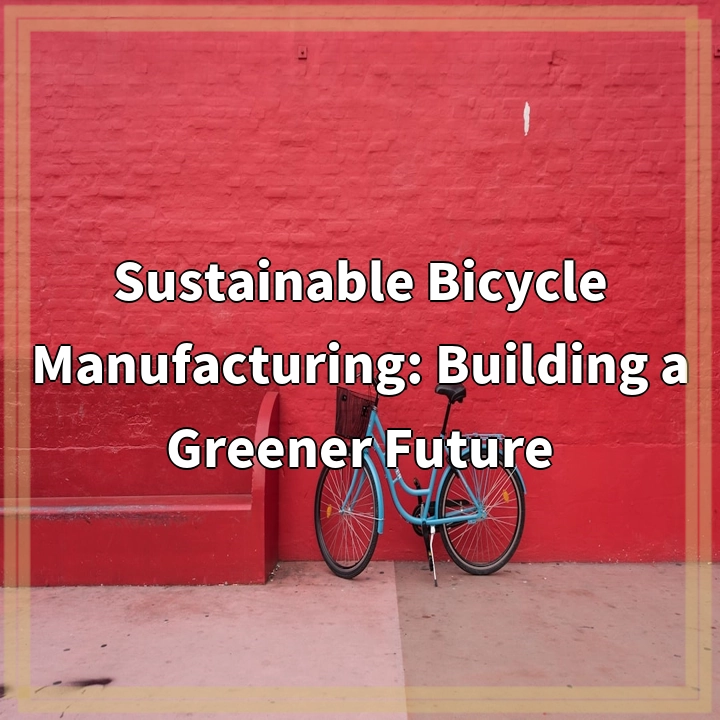
What is Sustainable Bicycle Manufacturing?
Sustainable bicycle manufacturing is the process of producing bicycles while minimizing the negative environmental impact. It focuses on reducing resource consumption, carbon emissions, and waste generation throughout the entire lifecycle of a bicycle, from raw material extraction to production, distribution, and disposal.
Real-World Problems Associated with Sustainable Bicycle Manufacturing
1. Raw Material Sourcing: One of the challenges in sustainable bicycle manufacturing is sourcing materials that are both durable and environmentally friendly. Traditional bicycle frames often use carbon fiber or aluminum, which have a significant environmental footprint in terms of production and disposal. Finding alternative materials that possess similar strength and durability characteristics without the negative environmental impact is crucial.
2. Energy-intensive Manufacturing Process: The manufacturing process itself can contribute to environmental degradation. Energy-intensive processes like welding, machining, and painting can lead to high carbon emissions if not done using energy-efficient technology. Implementing cleaner production methods and using renewable energy sources can help alleviate this issue.
3. Supply Chain Management: Managing a sustainable supply chain can be complex. From the sourcing of raw materials to distribution, ensuring that each step adheres to eco-friendly practices can be a challenge. Ensuring that suppliers adhere to sustainable practices and promoting transparency becomes vital in achieving a greener supply chain.
4. Disposal and Recycling: When bicycles reach the end of their life cycle, proper disposal and recycling become crucial. Many bicycles end up in landfill or incineration, contributing to waste and pollution. Encouraging recycling initiatives and promoting the use of biodegradable or easily recyclable materials can address this issue.
5. Consumer Awareness and Behavior: Educating consumers about the importance of sustainable bicycle manufacturing is essential. Many consumers may be unaware of the environmental impact associated with their purchase decisions. Encouraging them to choose bicycles made from sustainable materials and supporting brands that prioritize eco-friendly practices can drive change.
6. Financial Viability: Sustainable practices can sometimes come with increased costs, making it challenging for manufacturers to remain financially viable. Finding a balance between ecological responsibility and economic feasibility is crucial for the long-term success of sustainable bicycle manufacturing initiatives.

Solutions to Challenges in Sustainable Bicycle Manufacturing
Here are some solutions to address the real-world problems associated with sustainable bicycle manufacturing:
1. Material Innovation:
Investing in research and development to find sustainable alternatives to traditional materials like carbon fiber and aluminum. Exploring materials such as bamboo, recycled steel, or bio-based composites can reduce the environmental impact of bicycle manufacturing.
2. Energy-efficient Manufacturing:
Implementing energy-efficient technologies and processes in manufacturing facilities. This can include using renewable energy sources, optimizing production workflow, and implementing eco-friendly painting and coating methods.
3. Sustainable Supply Chain:
Establishing partnerships with suppliers that adhere to sustainable practices. Implementing strict supplier criteria, conducting audits, and promoting transparency within the supply chain can ensure that sustainable principles are maintained throughout the production process.
4. End-of-Life Management:
Designing bicycles with ease of disassembly and recyclability in mind. Promoting recycling initiatives and supporting the development of efficient recycling systems can help reduce waste and ensure proper disposal of bicycle components.
5. Consumer Education:
Raising awareness among consumers about the environmental impact of their choices when purchasing bicycles. Providing information about sustainable materials, certifications, and eco-friendly brands can empower consumers to make more environmentally conscious decisions.
6. Cost-effectiveness:
Finding innovative solutions to balance sustainability with economic viability. This can involve exploring funding options, promoting market demand for sustainable bicycles, and collaborating with stakeholders to mitigate the additional costs associated with eco-friendly practices.















